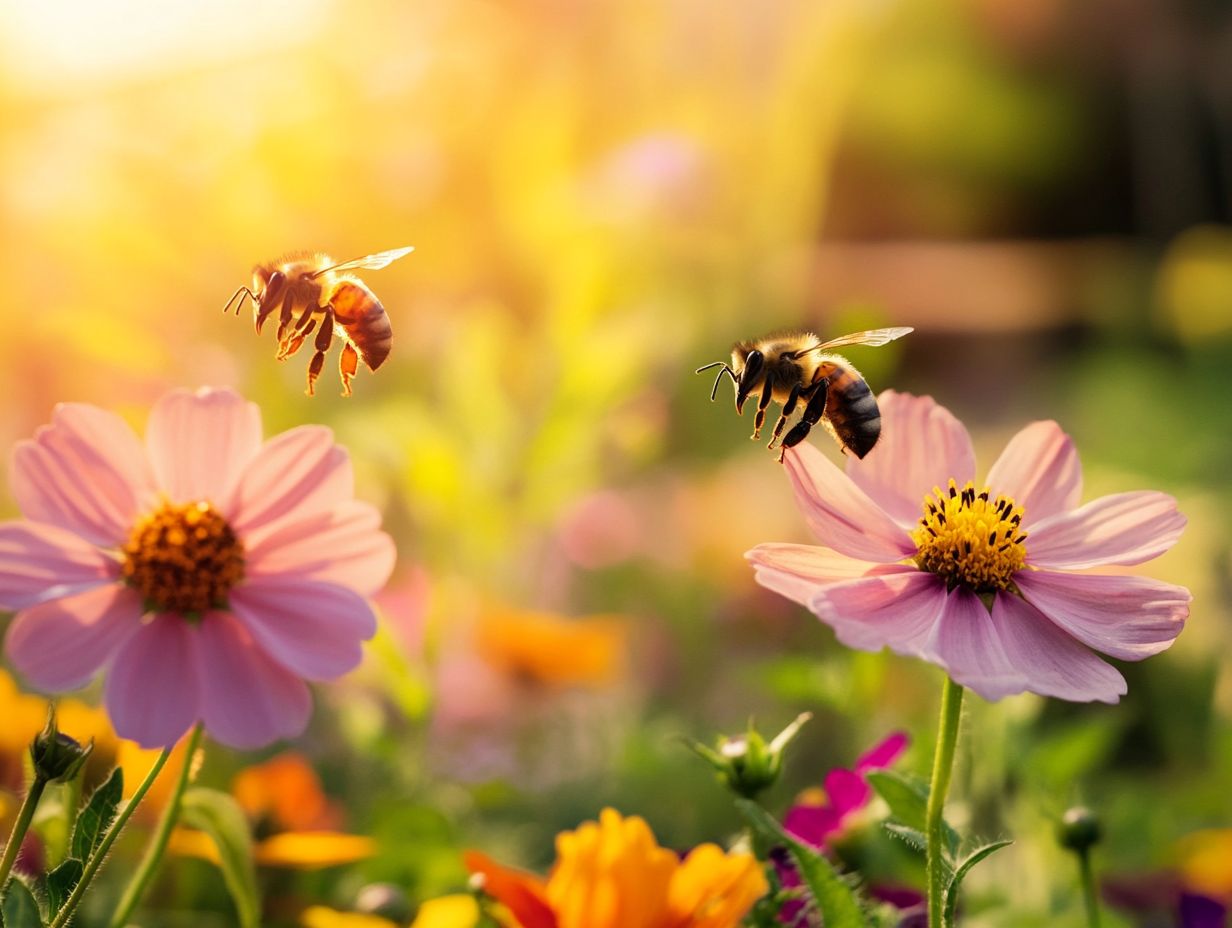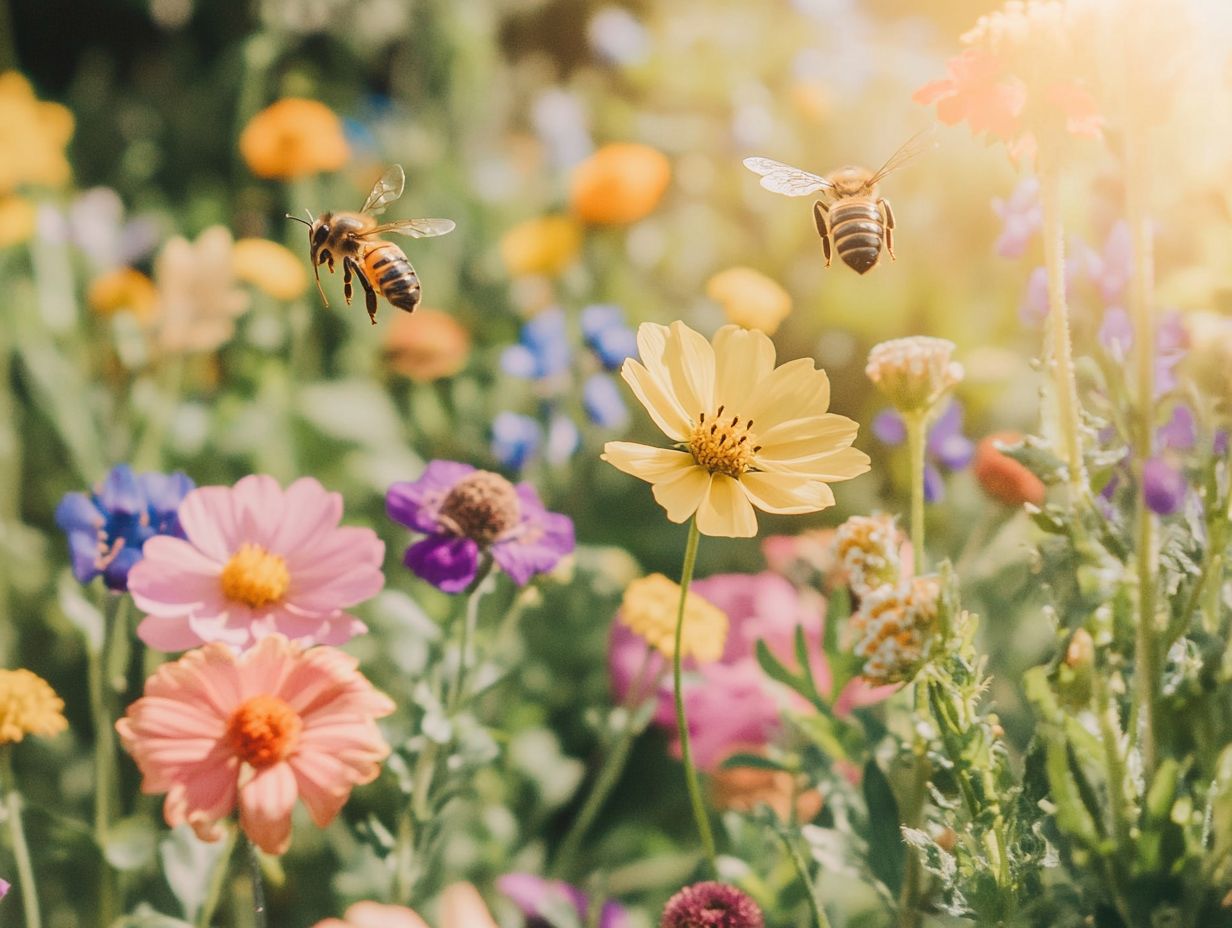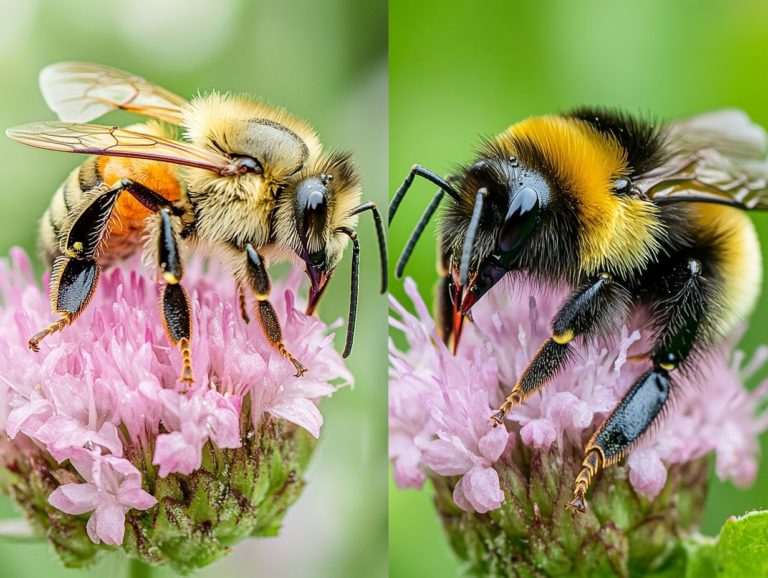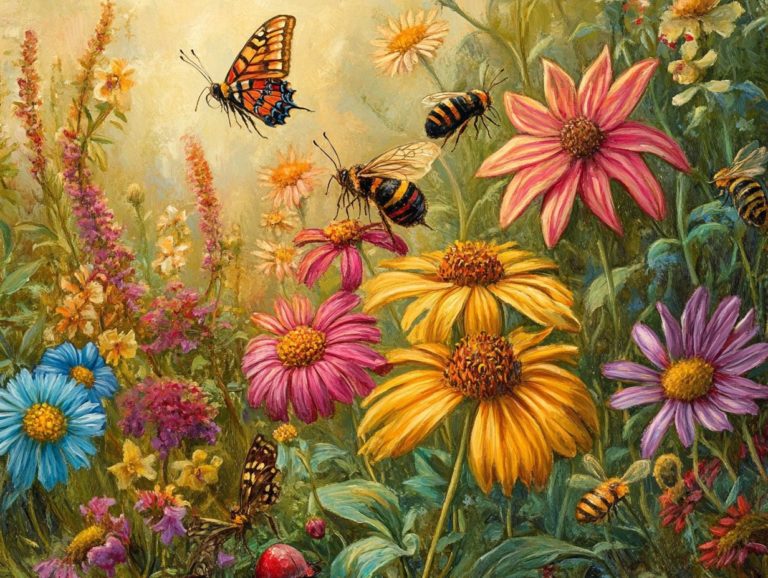5 Pollination Strategies Used by Bees
Bees do more than just buzz around; they are essential players in our ecosystem, thanks to their remarkable pollination strategies that support the environment and biodiversity.
Consider the energetic buzz pollination technique and the intriguing ways both solitary and social bees navigate their surroundings. Each approach highlights the incredible ingenuity of nature itself, contributing significantly to our agricultural systems.
Dive into the diverse types of bees, their unique methods for collecting pollen and nectar, and the challenges they encounter, including pests and habitat loss. Discover how you can contribute to protecting these vital pollinators.
Embark on this journey with us as we unveil the extraordinary world of bee pollination!
Contents
- Key Takeaways:
- 1. Buzz Pollination (Sonication)
- 2. Nectar Robbing
- 3. Cuckoo Bees
- 4. Solitary Bees
- 5. Social Bees
- How Do Bees Play a Vital Role in Pollination?
- Frequently Asked Questions
- What are the 5 pollination strategies used by bees?
- How does buzz pollination work?
- What is pollen basket collection and why do bees do it?
- What is nectar robbing and how does it affect pollination?
- How does hovering benefit bees during pollination?
- What is floral constancy and why is it important for pollination?
Key Takeaways:

- Bees use various pollination strategies, including buzz pollination, nectar robbing, cuckoo bees, solitary bees, and social bees.
- Bees play a crucial role in pollination, ensuring the reproduction of many plant species and the production of fruits and seeds.
- Threats such as habitat loss, pesticides, and climate change pose significant risks to bee pollination and can be mitigated through conservation efforts.
1. Buzz Pollination (Sonication)
Buzz pollination, or sonication, is a remarkable process employed by certain bee species, such as bumblebees and the Japanese Orchard Bee, to extract pollen from flowers specially adapted for this technique like tomatoes, blueberries, and orchids. This method plays a crucial role in the reproduction of countless flowering plants and significantly impacts global biodiversity, agricultural productivity, and the overall health of ecosystems.
These bees vibrate their flight muscles to generate a specific frequency, releasing pollen from the anthers of flowers, making it ripe for collection. This tactic benefits the bees, who gather food efficiently, and the plants that depend on this unique interaction for successful fertilization. For example, buzz pollination enhances fruit set in tomatoes, while blueberries thrive thanks to this process.
This symbiotic relationship highlights the importance of maintaining robust bee populations. Their effective pollination practices boost agricultural yields and ensure the health of wild plants, ultimately supporting food security and ecological balance. The energy invested by these bees in their pollination services is crucial for thriving ecosystems.
2. Nectar Robbing
Nectar robbing is a fascinating behavior observed in certain pollinators, including some species of bees, butterflies, and bats. These creatures extract nectar from flowers without contributing to the pollination process, creating a deceptive interaction that can impact the reproductive success of the flowers involved.
This behavior undermines the reproductive strategies of plants and raises intriguing questions about ecological balance in their habitats. As nectar robbers, these pollinators often target specific blooms, skewing the effectiveness of sexual reproduction and potentially leading to shifts in plant populations.
For example, flowers like columbines and certain species of orchids frequently fall victim to nectar robbing. In response, these plants may develop adaptive traits, such as altering their nectar production rates or modifying flower structures to deter these exploitative visitors. This showcases the intricate balance and ongoing interactions within ecosystems.
This fascinating dynamic reveals how plants and pollinators depend on each other, where changes in pollination strategies can ripple through the broader ecosystem, resulting in significant ecological repercussions.
3. Cuckoo Bees
Cuckoo bees offer a fascinating look at bee life. Females lay their eggs in the nests of other bee species, outsourcing their larvae’s care while benefiting from the pollination services of their unsuspecting hosts.
This behavior is not just survival; it s a complex relationship shaped over millions of years among various bee species.
The life cycle of cuckoo bees is intriguing. Their larvae consume the food supply of their hosts, including stored pollen and developing offspring.
This nesting strategy impacts not just individual hosts but also entire ecosystems. Cuckoo bees can change competitive interactions, affecting which species thrive or decline.
Such changes ripple through the pollination network, influencing plant success and local biodiversity.
4. Solitary Bees

Solitary bees are vital pollinators that support ecosystems and agriculture. Species like Andrena and the Japanese Orchard Bee have unique nesting behaviors that enhance biodiversity and support many flowering plants, including apples and pears.
Unlike honey bees, which live in colonies, solitary bees create individual nests in hollow stems or soil. This independence allows them to pollinate a diverse range of flowers, especially native varieties rich in nutrients.
Their role in cross-pollination is crucial for maintaining genetic diversity among plants. Protecting their habitats helps ensure the health of our environment.
5. Social Bees
Social bees, especially honey bees, are key players in pollination. They significantly boost agricultural productivity and are essential for ecosystem health.
In their colonies, bees have specific roles like foraging, nursing, and maintaining the hive. This teamwork maximizes their foraging efficiency and ensures colony survival, benefiting farmers and vital crops like almonds and blueberries.
Social bees also enhance ecosystem resilience by promoting plant diversity. Their conservation is crucial for maintaining ecological balance for future generations.
How Do Bees Play a Vital Role in Pollination?
Bees are among the most critical creatures that help plants reproduce. They play an essential role in the reproduction of numerous flowering plants.
By transferring pollen between flowers while gathering nectar, they enhance biodiversity and support agricultural systems. This process sustains various species of fruit trees, vegetables, and wild flora, all of which are vital for a balanced ecosystem.
Their remarkable ability to navigate and communicate through intricate dances allows them to effectively locate and exploit a diverse array of floral resources. Different species of bees, from honeybees to solitary ground-dwelling varieties, display unique specializations that contribute to the pollination of specific crops and native plants, enriching the ecological web.
These pollination processes also involve other factors like wind and water, which play complementary roles in plant reproduction. For example, while honeybees thrive in social colonies, other species have adapted to pollinate flowers with distinct characteristics that align with their morphology and behavior.
The presence of nectar guides in flowers often directs pollinators efficiently, enhancing the overall pollination process. This rich diversity not only boosts agricultural yields but also fortifies the resilience and health of ecosystems.
These industrious pollinators are essential for sustaining life on Earth, and their efforts are nothing short of amazing!
What Are the Different Types of Bees and Their Pollination Strategies?
Different types of bees exhibit a fascinating array of pollination strategies that are essential for the successful transfer of pollen among a diverse range of plant species. Solitary bees often hone in on specific blooms, while social bees, like honey bees, adopt collective foraging techniques to maximize their pollination efficiency.
The diverse strategies used by bees and other pollinators, like hummingbirds, moths, and bats, ensure the blossoming of flowers and the setting of fruit. Consider solitary bees, such as mason bees. Their unique approach involves visiting only selected flowers, enhancing their effectiveness as pollinators for plants that require precise pollen transfer.
In contrast, social bees operate in larger groups, allowing them to cover greater distances and visit multiple flower types during a single foraging expedition. This behavior not only aids in cross-pollination but also exemplifies a remarkable adaptation to varying ecological niches.
These pollinators also support commercial crops, underscoring the importance of conservation efforts to protect their habitats. The intricate relationships these bees form with particular flowers underscore the delicate balance within ecosystems.
This highlights the crucial role bees play in maintaining biodiversity and the overall health of our environment. For instance, the symbiotic relationship between bees and orchids is an example of nature’s intricate design.
How Do Bees Collect Pollen and Nectar?

Bees possess remarkable anatomical features and behaviors that allow them to efficiently gather pollen and nectar from flowers. Their hairy bodies trap pollen grains, while their long tongue-like structure adeptly extracts nectar, a vital energy source that fuels their activities and facilitates the pollination process.
Some bees, like the Japanese Orchard Bee and Andrena, have specialized adaptations for collecting pollen. These adaptations not only improve their foraging efficiency but also significantly influence the life cycles of numerous plants.
The intricate relationship between bees and flowering plants is essential; for example, blossoms like lavender and sunflowers showcase vibrant colors and sweet fragrances that make them particularly enticing to these pollinators. Orchids are another example of flowers that have a unique pollination mechanism facilitated by bees.
The flower petals act as landing pads, providing bees with easy access to nectar while ensuring they collect and transfer pollen from one bloom to another. This process is crucial for plant fertilization, underscoring the importance of bees in maintaining ecological balance and enhancing biodiversity.
Nectar guides on petals also help bees locate nectar more efficiently, which is essential for the pollination process.
What Are the Threats to Bee Pollination?
Bee populations are currently facing a multitude of threats that put their remarkable ability to pollinate at risk.
Habitat loss, pesticide exposure, and the increasing prevalence of pests and diseases can weaken bee colonies. This disruption affects both ecosystems and agriculture.
These challenges not only endanger the survival of bee species but also carry significant consequences for pollination services, which are vital for plant reproduction and food production. A decline in bee numbers leads to diminished crop yields. It also reduces biodiversity, affecting flowering plants that rely on bees for successful pollination. Moreover, the loss of bees could significantly impact commercial crops like almonds and tomatoes.
You can help by restoring natural habitats and minimizing pesticide use. Advocating for organic farming practices enhances pollinator health. Supporting initiatives like planting wildflower meadows is critical.
Engaging in public awareness campaigns is vital. Educating your community about the importance of bees and supporting local beekeepers helps preserve these essential pollinators. You can also encourage sustainable agricultural practices that minimize habitat disruption.
How Can We Help Protect Bees and Their Pollination Strategies?
Protecting bees and their vital pollination strategies demands your active involvement in conservation, habitat restoration, and sustainable agricultural practices that prioritize the well-being of these essential pollinators while enhancing biodiversity and ecosystem health. Supporting policies that protect pollinator habitats, such as maintaining bee-friendly green spaces and wildflower meadows, is crucial for our future.
You can take the first step by planting a vibrant mix of native flowers in your garden, providing critical food sources for bees throughout the growing season. It’s also crucial to reduce pesticide use; embracing organic gardening techniques will help create a safer haven for these important insects. Planting a variety of blooms ensures that bees have access to diverse nectar sources.
On a broader scale, you can support bee populations in your community by advocating for policies that protect pollinator habitats. This includes creating bee-friendly green spaces, maintaining wildflower meadows, and ensuring that agricultural practices are sustainable and supportive of biodiversity.
In conclusion, the health of bee populations is linked to ecological balance. Your efforts are crucial for safeguarding their survival and benefiting all pollinators, including butterflies, bats, and birds. Efforts to conserve bees are essential to protecting the broader ecosystem, which benefits all pollinators as well as ensuring the health of fruit trees and other plants.
Join us in protecting bees today and ensure a vibrant, healthy ecosystem for future generations!
What Are the Benefits of Diverse Pollination Strategies in Bees?
Diverse pollination strategies employed by various bee species play a crucial role in enhancing the ability of ecosystems to thrive and agricultural diversity.
These bees ensure crops receive reliable pollination services, significantly boosting yields and promoting biodiversity. Pollination by bees is essential for the production of numerous fruits and vegetables, including apples, pears, and tomatoes.
For example, some bees are specialists, visiting specific types of flowers to effectively transfer pollen between compatible plants. In contrast, others take on a more generalist approach, pollinating a wide range of species. This diversity is key to enhancing ecosystem stability, as it fosters plant reproduction and genetic variation both essential for adapting to changing environments.
Different pollinators such as hummingbirds, moths, and even the wind also play important roles in the pollination process.
In agricultural settings, consider the almond orchards of California, where a blend of honeybees and native bees results in increased almond yields. This example shows how exciting it is that a variety of pollinators not only boosts crop production but also nurtures a healthier, more resilient ecosystem overall.
Similarly, diverse pollination strategies help a variety of agricultural and wild plants thrive, promoting ecosystem health and food security.
Frequently Asked Questions

What are the 5 pollination strategies used by bees?
The 5 pollination strategies used by bees are buzz pollination, pollen basket collection, nectar robbing, hovering, and floral constancy.
How does buzz pollination work?
Buzz pollination is a technique where bees use their wings to create vibrations that release pollen from the anthers of flowers. This method is commonly used by bumblebees for plants with tightly closed flowers, such as tomato plants.
What is pollen basket collection and why do bees do it?
Pollen basket collection is when bees collect pollen using specialized hairs on their legs and store it in a pollen basket on their hind legs. This pollen is used as a food source for their young, ensuring the survival of their colony.
What is nectar robbing and how does it affect pollination?
Nectar robbing is when bees or other insects bite a hole in the base of a flower to access the nectar without coming into contact with the flower’s reproductive parts. This can reduce the amount of pollen transferred and disrupt the pollination process for that flower.
How does hovering benefit bees during pollination?
Hovering is when bees hover in front of flowers to collect nectar without landing. This allows them to quickly move from flower to flower, increasing their efficiency in pollination.
What is floral constancy and why is it important for pollination?
Floral constancy is when bees prefer to visit only one type of flower at a time, rather than switching between different types. This ensures that pollen from one species of flower is not unintentionally transferred to another, promoting effective pollination for the specific plant species.
Explore the fascinating world of bees and their pollination strategies. Join us in protecting these vital pollinators!






